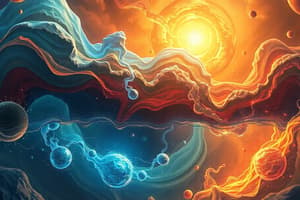Podcast
Questions and Answers
Which of the following states of matter has a fixed volume but not a fixed shape?
Which of the following states of matter has a fixed volume but not a fixed shape?
- Gas
- Liquid (correct)
- Plasma
- Solid
A physical change produces a new substance.
A physical change produces a new substance.
False (B)
What happens to the particles of a substance as the temperature increases?
What happens to the particles of a substance as the temperature increases?
The particles move faster and create more collisions.
The chemical formula for a glucose molecule is C______H______O______.
The chemical formula for a glucose molecule is C______H______O______.
Match the following states of matter with their particle arrangement:
Match the following states of matter with their particle arrangement:
Which mineral has a Mohs hardness of 6?
Which mineral has a Mohs hardness of 6?
What mineral can scratch quartz according to the Mohs scale?
What mineral can scratch quartz according to the Mohs scale?
Which of the following best describes a chemical sedimentary rock?
Which of the following best describes a chemical sedimentary rock?
What is a characteristic feature of an element?
What is a characteristic feature of an element?
What is a sign that a chemical change has occurred?
What is a sign that a chemical change has occurred?
Flashcards
Solid state particles
Solid state particles
Particles in a solid are tightly packed and vibrate in place.
Liquid state particles
Liquid state particles
Particles in a liquid are loosely packed and can flow.
Gas state particles
Gas state particles
Particles in a gas are widely spaced and move freely.
Physical change
Physical change
Signup and view all the flashcards
Glucose molecule
Glucose molecule
Signup and view all the flashcards
Reaction rate
Reaction rate
Signup and view all the flashcards
Temperature's effect
Temperature's effect
Signup and view all the flashcards
Mineral Hardness
Mineral Hardness
Signup and view all the flashcards
Chemical sedimentary rock
Chemical sedimentary rock
Signup and view all the flashcards
Element
Element
Signup and view all the flashcards
Mohs Hardness Scale
Mohs Hardness Scale
Signup and view all the flashcards
Chemical Change
Chemical Change
Signup and view all the flashcards
Mohs Hardness 1
Mohs Hardness 1
Signup and view all the flashcards
Mohs Hardness 10
Mohs Hardness 10
Signup and view all the flashcards
Hardness of unknown mineral
Hardness of unknown mineral
Signup and view all the flashcards
Study Notes
State of Matter
- Solids have a fixed shape and volume. Particles are tightly packed and vibrate in fixed positions.
- Liquids have a fixed volume but no fixed shape. Particles are close together but can move around.
- Gases have no fixed shape or volume. Particles are far apart and move freely in all directions.
Physical Changes
- A physical change involves a change in the state of matter (solid, liquid, gas), but the substance's chemical makeup remains the same.
- Examples of physical changes include melting, freezing, evaporation, condensation, sublimation and dissolving
Molecular Structure of Glucose
- Glucose contains 6 carbon atoms, 12 hydrogen atoms, and 6 oxygen atoms.
Reaction Rates and Temperature
- Increasing the temperature of a reaction increases the rate of reaction.
- Higher temperatures cause particles to move faster, leading to more frequent and energetic collisions between molecules. These collisions result in more successful reactions.
Studying That Suits You
Use AI to generate personalized quizzes and flashcards to suit your learning preferences.




